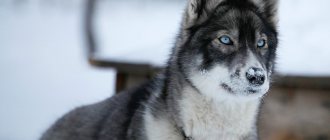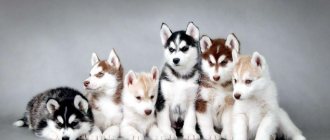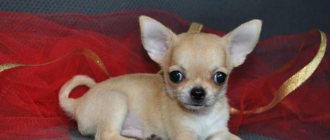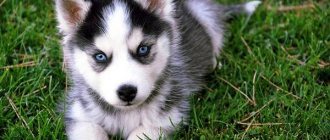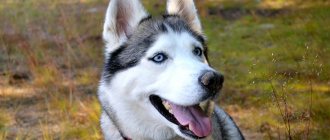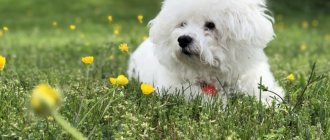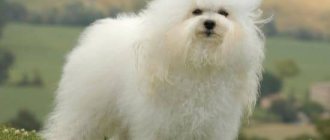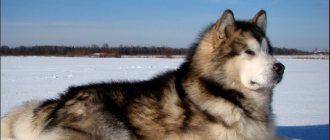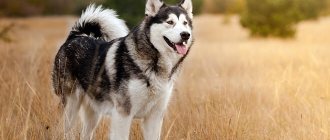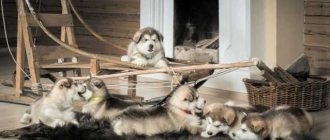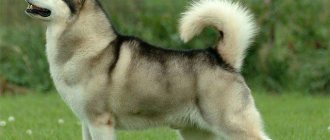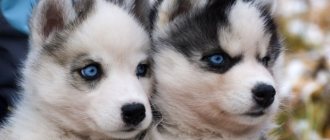Description of the Alaskan Klee Kai breed
Popularity 189th place among 263 dog breeds
Lifespan:
13-14 years old
Breed group:
Withdrawn
Height:
standard: 38-42 cm, mini: 33-38 cm, toy: 28-33 cm
Country of origin:
USA
Average price:
5000 dollars (about 350 thousand rubles)
Weight:
standard: 10 kg, mini: 7 kg, toy: 4.5 kg
Latest articles Cat health
Rabies vaccination for cats: choice of vaccine, necessity, schedule 01/22/2022 4 0 0
Selection and adaptation
TOP 20 best cat breeds for families with children 01/22/2022 25 0 0
Price
Considering the rarity and novelty of the breed, prices in Russia for purebred mini-huskies range from 350 thousand rubles.
There are two key myths found on the Internet:
- A defective puppy can be bought for 30-60 thousand rubles. A purebred, properly bred and pedigree Klee Kai, even if not suitable for show standards, cannot be worth that much. Breeders spend enormous efforts to maintain breeding dogs of this rare breed.
- It is cheaper to buy a mini-husky puppy in the USA. No American breeder sells dogs privately. But if a miracle happens and someone manages to reach an agreement, you will have to study the laws on the export of dogs from the States. One of them says: you cannot export animals that have not been vaccinated against rabies. In Russia, dogs are vaccinated at 2 months, and taken from three months. The dog is given to American buyers at 2 months, and the necessary vaccinations for import into Russia are given to the dog at 3.5, plus 30 days of quarantine. It turns out that the puppy is taken away at 4.5 months. These 2.5 months. above are considered overexposure at the expense of the buyer, which includes feeding, care, etc. We add these expenses to the price of the dog.
And this is just one nuance that you will have to thoroughly study when buying a Click Kai in the USA.
Key facts
The breed is a small husky, or northern spitz-like dog, intended for keeping in city apartments or small houses. These are very cute, charming, friendly, incredibly smart furry companions who love an active lifestyle, live communication, fun and active games, and long walks in the fresh air.
These are unique pets with a special charm. The main characteristic of the Alaskan Klee Kai breed is its almost exact resemblance to large Siberian Huskies with tiny body parameters. In appearance they resemble small, cute wolf cubs.
These natives from Alaska are easy-going and get along well with other four-legged friends. Despite their small size, they grow into good watchmen, capable of, if not biting the enemy, then at least warning the owner in time about possible danger.
They have an incredible talent for imitating human speech. Possessing excellent vocal skills, they can sing. The description of the Alaskan Klee Kai breed says that many dogs behave like cats: they wash themselves imposingly, slowly lick their paws, and rub against people’s legs.
Despite the fact that the breed was recently bred artificially, the life expectancy of the Alaskan Klee Kai is very long. A small husky can live 15 years.
Breeding
Currently, only professional nurseries are engaged in breeding Alaskan Klee Kais. The largest “number of heads” is found in the breed’s homeland – America. There are a small number of private breeders in Europe (England, Norway, France).
In Russia there are currently about five official places to purchase litters, and it took dog breeders several years to establish relationships with foreign suppliers of the breed. Only in 2013 did the first individuals appear on the Russian market.
American breeders do not sell Klee Kai puppies to private owners.
History of the origin of the Alaskan Klee Kai
When compared with other “northerners”, the breed is considered quite young. The origin story is as follows: in the 1970s, one young girl from Alaska, whose name was Linda Sparlink, went with her husband to visit her family in Oklahoma. While visiting, she saw a wonderful pet named Curis (translated from English as “curious,” “strange,” “inquisitive”).
He was exactly like a large husky, but much smaller in size, with very docile and exemplary behavior. The girl was so touched and admired by the miniature furry inhabitant of the house that she subsequently decided to take him in and then start breeding similar small dogs.
Those around were surprised, delighted, simply perplexed when they met such a strange, sweet creature. At that time, a large number of American residents wanted to make four-legged friends, but in narrow apartments this gave rise to difficulties. The appearance of decorative, tame quadrupeds caused a real stir.
Linda developed a large and detailed plan for breeding a new type of dog through mating and crossbreeding. The main roots belonged to huskies, Alaskan malamutes, huskies, and Eskimo dogs. After about 20 years of breeding as a professional, the enterprising northern woman developed the desired breed. Journalist Eileen Gregory was the first to see and photograph her.
In the 1985s, Sparlink gave a puppy to her close friends for a holiday. It was a real explosion for those years. The woman received an endless number of messages and requests for such a “gift” by phone and in letters. After some time, her house turned into a local landmark in Alaska.
Everyone who bought a new puppy agreed to send various information, photographs, any information about development, growth, and behavior changes. After some time, dog experts conducted a detailed description of the characteristics and appearance, and then in America they created the official Klee Kai Club.
Eileen Gregory greatly influenced the recognition of the created species by the English dog breeding community, becoming the owner of two beautiful dogs. In 1994, the first presentation of Klee Kais took place at the International Exhibition in Danver.
Dogs were included in the official registry of Alaska in 1995 of the 20th century. In 1997, they became full representatives of the United Canine Union and received universal recognition.
For a long time, Linda Sparlink continued to strictly cull dogs according to strict criteria. But the pressure from dog breeders was too strong, so she had to soften her own demands and leave the Club.
Appearance of an Alaskan Klee Kai
Klee-kai are divided into three categories: standard, mini and toy. Representatives of different groups have different body sizes. They are all proportional, so it is difficult to determine which group it belongs to just from a photo of an Alaskan Klee Kai.
General impression
In addition to their overall mass, Alaskan quadrupeds differ from large huskies in the funny shape of their crocheted tail. They seem to have a black mask painted on their face, emphasizing their mirrored eyes and elongated nose.
Head
The skull has an elongated, triangular shape. There are practically no skin folds on the head. The back of the head is in the form of a small tubercle, the frontal lobe is generally rounded with a small depression in the middle. The lower jaw is very strong, a strong and sharp grip is developed.
Neck
The neck is medium in length, level, and set high. Thanks to this head position, pets look very stately and graceful. When walking or running, they slightly stretch their necks forward, as if cutting through the space in front of them with a sharp nose.
Torso
The shape of the body is rectangular, oblong. There is a slight curve in the lumbar region. They have a very strong and robust back, as well as a powerful thoracic spine. This was passed on to dogs from large Siberian descendants. The rounded chest is pushed forward. The pelvis is significantly narrower than shoulder width. The tummy is expressively tucked.
Forelegs
The musculoskeletal system is powerful, with flexible joints and strong muscles. Compared to the length of the body, the paws are quite short. Limbs are straight and slender. The elbows are positioned directly relative to the body. The pasterns are round in shape with soft pads hidden behind a thick mop of hair.
Hind limbs
Despite the narrow pelvis, the thighs are very strong, with clearly visible muscles. The hind legs are slightly shorter than the front legs. In the standard position they have a smooth oval curve.
Tail
The tail has an unusual, even wonderful shape. It looks like a small fluffy bagel, with one corner turned toward the back. It is tilted 90 degrees relative to the spine, but can tilt slightly to one side. According to standards, the tail should be dark or black.
Movements
The nature of the movements is smooth. Quadrupeds walk confidently, run very quickly, and move deftly while playing or hunting. Without much effort, these little beauties quickly climb heights twice their own height.
Wool
Medium length fur. The undercoat is thick. Heavy and straight hair has a dense structure. Due to the massive fur, a kind of “apron” is formed on the neck, as if supporting the head and chin in a constantly raised position. Most of the soft fur is on the belly, chest, ears, and paw pads.
Color
Different colors of the Alaskan Klee Kai are acceptable: gray, red, black. The main characteristic, standard feature is a black mask on the face. Because of this detail, the dogs have thick eyebrows that match the main color. The forehead and tail are usually slightly darker than the rest of the body.
Dimensions
The size of the Alaskan Klee Kai varies greatly and is therefore divided into three groups. Standard type parameters: height – about 35-43 cm, body weight – 6-9 kg. The mini species is usually 30-35 cm tall and weighs from 4 to 6 kg. In the toy species, the height of the Alaskan Klee Kai will be approximately 25-30 cm, and the weight will be 3-4 kg.
If the weight of an Alaskan Klee Kai exceeds 10 kilograms, most likely it is just a husky mix and not a purebred Alaskan.
Possible defects
Breeders strive to preserve the purity of the breed, so any deviation from the standard is considered a defect.
Possible defects
- Lack of symmetry in the mask on the face.
- Close placement of the eyes or their bulging shape.
- Narrow or underdeveloped sternum.
- Light eyelids.
- Saggy belly.
- Direct bite.
- Dull face.
- Skin folds on the head or body.
- The coat is too long.
To disqualify an individual, it is sufficient to identify pronounced defects. The basis for culling an individual is considered to be its unjustified manifestation of aggression or cowardice. Male dogs are also disqualified if their testicles are not descended. All culled individuals are subject to sterilization to eliminate the possibility of transmitting their characteristics to offspring and distorting breed standards.
Character of the Alaskan Klee Kai
These creatures are one of the cutest and kindest animals. They, of course, can growl or bark, but this happens only in the most rare and extreme cases. Amazing pets combine all sorts of positive qualities and characteristics that can only belong to dogs. Many people call the character of the Alaskan Klee Kai simply wonderful.
Excellent students in training - that's about them. The main thing in this painstaking, important task is patience and a great desire to teach and raise your own furry friend. With these dogs, even inveterate adherents of home gatherings will love movement and an active lifestyle. Fluffies are always full of energy, the desire to move, play, and charge everyone around with positivity.
They cannot stand long separations or loneliness. Without attention, mini-wolf cubs gnaw everything that gets in their way: shoes, things, toys, furniture.
Their barking can be called a kind of song. The vocal cords of pets have a special structure, which is why a certain howling onomatopoeia of human speech emerges.
Dogs build excellent relationships with other pets. They immensely love to jump and frolic with children, posing as true hunters. However, if the dog is offended by pulling the ears, tail or roughly pushing, he may bare his teeth, growl or even claw; he will not allow himself to be offended. Therefore, it is important for adults and children to understand that this is not a toy, but a living creature.
Alaskan mini-huskies behave suspiciously towards strangers, but over time they get used to it. Despite their small size, if danger arises, they instantly make noise, warning of a possible threat.
One of their favorite pastimes is digging small holes and wide holes under fences, stairs, trees or houses. Sometimes they dig burrows for various wild rodents, which can be carriers of various infectious diseases. Therefore, it is important to monitor your four-legged dog, even if all vaccinations are up to date.
Education and training
From birth, dogs need communication and large doses of attention. They are not shy, therefore, if necessary, they skillfully defend themselves, for example, they can growl, bark loudly, and in extreme cases, bare their teeth or scratch.
The process of training and raising an Alaskan Klee Kai is best done in the form of a game. This is how new commands, lessons, and prohibitions are learned. It is important to praise your pet in a timely manner. But mischief and disobedience must be stopped with a threatening tone or appropriate punishment, since the little pupil must see authority in the owner and unconditionally obey him.
Intelligence and intelligence both facilitate and complicate the learning process. Klee Kai pick up new commands with incredible speed, but are not always willing to follow them. This shows the stubbornness inherited from our great Siberian ancestors.
Constant development, training in new commands – this is what is vital for representatives of this breed. It is important to follow a certain training plan, without loading the “student” with a mountain of new lessons at a time, but also without taking long breaks between the learned material. Order is important here. It is not recommended to show aggression, because animals remember a bad or dismissive attitude for a long time.
It is better to dilute clear lesson plans with games and competitions. This could be Frisbee, steeplechase, chasing a bicycle, repeating learned commands to fun, dynamic music.
From birth, your four-legged dog should be accustomed to wearing a collar and leash. There are frequent cases of little pranksters escaping. Of course, a mini-husky should know its name from puppyhood and always quickly respond to it.
Health and Diseases of the Alaskan Klee Kai
Klee Kais have impeccable health and have a strong immune system. All this appeared thanks to strict selective selection. In some cases, problems with blood clotting may occur, but the likelihood is very small. There is a small percentage of developmental disorders of the hip joints, and there is a risk of eye diseases. No genetic diseases have been found in the breed.
However, a systematic examination by a veterinarian once every six months or a year is required. These furry friends are real long-livers. With proper care, proper diet, and timely treatment, they move actively and, to the joy of their owners, live up to twenty years.
Features of feeding and diet
Pets are very active, so their diet should be sufficiently high in calories, but not exceeding the norm. The diet is best made up of foods containing a lot of protein and microelements - in particular calcium. The following will be especially useful:
· cereals; · vegetables; · low-fat poultry meats; · sea fish; · beef, rabbit meat: steamed or boiled; · some by-products; · porridge with water or with added milk (half with water).
Periodically you should give fermented milk, for example, kefir, yogurt, cottage cheese. Warm whole milk once or twice a day will benefit babies, but it is not advisable to give it to an adult dog. What is prohibited from offering to Klee Kais:
· raw meat, eggs; · highly peppered or salted food; · pork; · bones; · smoked products; · various sweets, baked goods.
It is better to choose premium quality commercial food. Veterinarians recommend not mixing food with homemade food, this can cause disruption of the digestive tract and provoke the occurrence of illnesses. The animal should always have access to clean drinking water at room temperature. Both purchased water from bottles and from the tap will do, which is best left to settle for about six to seven hours.
Care and maintenance
The basic rules for the care and maintenance of an Alaskan Klee Kai are timely walking (on average 2-3 times a day), a properly formulated diet, hygiene, a lot of activity and attention. The dogs are pretty clean. They themselves skillfully clean their fur, eyes and ears, and lick their paws. But the owner should do this 1-2 times a week, using shampoos, dry products, and conditioners while bathing. To comb out fur, you can purchase special brushes or mittens with small spikes at the pet store. For hygiene of the dog’s eyes and ears, you will need clean tissues and cotton pads.
Despite their small size, Klee Kais do not need clothing in winter. A natural fur coat provides great warmth even on the coldest days. These furry friends love large snowdrifts and puddles, so when walking you should learn to avoid such objects. But sometimes you can lower the leash, giving free rein to frolic.
Nutrition
They also don’t need special clothing and food. Easily tolerates severe frosts. Check the eyes and ears periodically to exclude inflammatory processes. As children, dogs love porridge, fermented milk products, meat, and bread. Not picky about food. You can buy food recommended by your veterinarian.
Klee Kai are not picky eaters and have good health.
Tips for choosing a puppy
Often the breeders themselves sell small purebred puppies. Or you can contact a breeding nursery with a good reputation and official confirmation of breeding this particular breed. First, inspect the premises and make sure that the Alaskan Klee Kai puppies are kept clean.
Look at the baby you like from head to tail. The ears should be clean, the eyes clear, the teeth white, the gums pink, and the coat soft. Watch his movements.
It is very important to see the mother of the puppies, take a closer look at her appearance, general condition and behavior of other babies from the litter. If you choose an animal to participate in exhibitions, it is better to get to know both parents. This will allow you to understand how fertile your chosen little Klee Kai is.
Photo
Admire these stunning photos of this dog breed (puppies and adult dogs):
Well settled
Find the kli kaya
